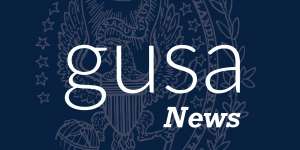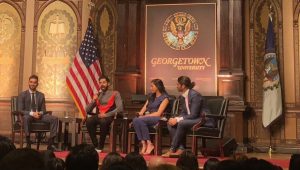Every day, over 300,000 classrooms nationwide are missing teachers. The United States currently faces an overwhelming shortage of public K-12 educators despite growing student enrollment. In teacher-training programs, the number of participants has fallen by more than a third since 2010, and in some states by as much as 80 percent. Even when people do decide to become teachers, it doesn’t mean they will continue in those jobs long-term. In D.C., 70 percent of public school teachers leave within five years.
With extreme wage stagnation and high levels of daily stress, it is no surprise fewer and fewer people want to go into education. Feb. 22 marked the two-year anniversary of the largest worker strike in a generation, when hundreds of thousands of teachers and their supporters walked out of classrooms in five states, including West Virginia and Oklahoma, demanding higher wages and better classroom conditions. The gains were minimal in comparison to rising costs of living and ever-increasing classroom sizes.
But poor working conditions are only one of the reasons behind the teacher shortage. Last December, Cornell students urged their university to reconstitute its undergraduate teacher-training program which was shut down along with the education major and education department in 2013. The shutdown was part of the growing perception that teaching was “beneath the dignity of an Ivy League school,” sending dangerous signals to the community that the university does not care about education as a career path. This apathy towards teaching seems to be shared among other elite schools. In spite of its long-held Jesuit tradition, Georgetown does not have an education major or an undergraduate teacher-training program.
The lack of resources for teaching is hypocritical coming from institutions filled with students who have benefited from learning from good teachers. Growing up in the New York City public school system, I witnessed teachers put their professional and private lives at risk for their students. It wasn’t a job they abandoned when they left the building at the end of the day. When I look back on the people who shaped my life, I remember my fourth grade teacher who let me stay after school with her because my parents were at work, and I didn’t want to be home alone. I remember my sixth grade teacher who used his own paycheck to buy our class supplies. And I remember my high school teachers who offered their homes to my friend experiencing domestic violence.
Great teaching isn’t all in the grand gestures. My Latin teacher taught me how it was possible to love something so many people thought was irrelevant, and my gym teacher challenged my perception of what a strong woman looked like. My English teacher introduced me to some of the greatest stories of all time, stories like Winesburg, Ohio and The Sound and the Fury, that taught me how to deal with loss and absent parents, and countless other lessons that could never be encapsulated by a single grade.
Teachers play pivotal roles in our development. But the growing trend in education to measure learning by standardized test scores has led to the under-appreciation of teachers in recent years. In 2015, New York Governor Andrew Cuomo, nicknamed “Ebeneezer Scrooge” by public school advocates, was criticized for his “test and punish agenda,” which, if implemented, would have made half of a teacher’s evaluation grade based on student performance on standardized exams. When we look at education as an acquisition of test scores, we begin to see teachers as mere fact-spitters and replaceable machines. It also doesn’t help when our Secretary of Education participates in the promotion of such negative perceptions. Betsy DeVos has called public schools a “dead end” and has cut billions from the Department of Education’s budget.
The lack of teaching programs at elite institutions amid these cultural changes sends messages to students and the nation devaluing teaching. These messages can greatly affect national policy and performance, and we’re already seeing the consequences of this dangerous trend. This year, the Trump administration’s budget proposal cut $2.1 billion from a program that directly funded teachers’ salaries, leaving states to scramble to cover the pay of 35,000 teachers. In the 2018 Global Teacher Status Index, Americans scored low, ranking 16th internationally. The country that placed first and scored the highest index possible was China, giving teachers the same status as doctors. China’s students then outperformed American students by 11 places on an international exam.
Americans shouldn’t need another Sputnik to remind themselves of the importance of investing in education. When teachers are treated better, students perform better, leading to more human capital and greater socioeconomic development. In the United States, education level remains a major factor in whether an individual will live in poverty. This is important because teacher shortages and uncertified instructors disproportionately affect underprivileged schools.
While many students do not see teaching as a suitable profession, they do recognize its attractive virtue in shaping lives. At Harvard, one in five students applies to Teach for America upon graduation. In 2017, Georgetown ranked second in the number of graduates it sent to the non-profit. The desire to work in underserved schools should be encouraged, but it is important to question the intentions of its participants, of whom only 10 percent are education majors. One article described the stunt as an “ethical alternative to Wall Street for college seniors looking for a short-term commitment.”
Although Teach for America encourages participants to continue after their two-year requirement, 80 percent of participants leave after 3 years, many to pursue more lucrative jobs or go to graduate school. The organization partners with graduate schools and offers their participants tuition benefits. While participants have the opportunity to get an advanced education degree, the nonprofit is commonly seen as a stepping stone to law school and partners with more law schools and medical schools than they do with schools offering education programs. Google has also been cited as an aggressive recruiter of Teach for America alums. With one semester at an elite institution costing over $50,000, it’s understandable that students may feel pressure to enter more financially promising fields. Such a high turnover, however, can be destabilizing to already vulnerable communities. While I am sure many participants see the engagement beyond a resumé boost, Teach for America cannot be the main solution to the teacher shortage. It cannot replace a degree in education or the completion of a robust teacher-training program.
The overwhelming number of graduates entering private sector professions strays away from the values they deemed so important as students, values like service and public engagement so commonly found in university mission statements. Elite universities must show their students they mean it when they say public service is important. They must provide and promote degrees in education and teaching-training programs. Until education is seen as a viable major, America’s teacher shortage will continue.
This piece isn’t meant to provoke guilt and convince us all to become teachers. It is our moral responsibility, however, as those who have reaped the benefits of good teachers, to ensure that access to this privilege continues and it expands. The negative effects of the teacher shortage will first appear among the most vulnerable and then advance to us all when we suffer from a less educated workforce. We must stand in solidarity with our educators and future students and vote against those who have continuously slashed school budgets. We cannot passively watch institutions shut down their education departments and public schools crumble in our shadows. Our teachers have taught us better than that.
Image Credit: Cade Shore





